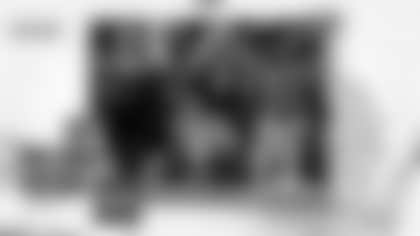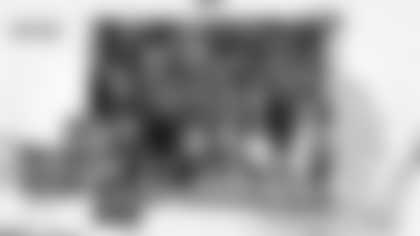Paul Hornung, described by Vince Lombardi as "the greatest player I ever coached," died Friday in his hometown of Louisville, Ky., after a long battle with dementia. Hornung was 84.
Selected No. 1 overall in the 1957 NFL Draft, with what was called the bonus pick, Hornung played for the Packers from 1957-62 and again from 1964-66. He was inducted into the Pro Football Hall of Fame in 1986, 11 years after he was inducted into the Green Bay Packers Hall of Fame.
Hornung, who stood 6-foot-2 and weighed 215 pounds, played quarterback at the University of Notre Dame and won the Heisman Trophy in 1956, but his first two coaches in Green Bay couldn't settle on a position for him. He was given a look at quarterback, but also started games at fullback and halfback.
His career took off in 1959, when Lombardi took over as coach, put him at left halfback and built his offense around him. The left halfback was the ball carrier on Lombardi's famed power sweep and what he called "the key operative" in his offense. For the power sweep to work, according to Lombardi, his halfback had to be able to throw the option pass. As a former quarterback and gifted athlete, who lettered in basketball as a sophomore at Notre Dame, Hornung was able run wide exactly as he would on the power sweep behind two pulling guards, stay under control and throw the ball if the defense was overplaying Lombardi's signature play.
Hornung's best seasons were 1960, when he set an NFL scoring record in a 12-game season that stood for 46 years, and 1961, when he was named the NFL's Most Valuable Player by the Associated Press and then MVP of the Packers' 37-0 victory over the New York Giants in the NFL Championship Game.
Although Hornung's statistics don't translate well to today's game, he was a rare triple-threat back, starting in 1958 and for five of Lombard's first six seasons. Not only could Hornung run and pass, he was the Packers' placekicker. As a result, when he set the scoring record in 1960, he scored 176 points on 15 touchdowns, 15 field goals and 41 extra points. Not until San Diego's LaDainian Tomlinson scored 186 points in 2006 in a 16-game season was the record broken.
In 1961, Hornung also set the Packers' single-game scoring record with 33 points on Oct. 8 against Baltimore. In the NFL title game that year, Hornung, again, broke a scoring record with 19 points and led all rushers with 89 yards on 20 carries. And what was remarkable about his sweep of MVP honors that season was that he rarely practiced after being called up for active military duty near midseason. Then, for the championship game, he needed a pass from the Army – with a little assistance from President John F. Kennedy – to be able to practice before the game and play.
Hornung suffered a serious neck injury in 1960 and a knee injury in 1962, which contributed to him missing 12 games over his final four seasons. He also was suspended by NFL commissioner Pete Rozelle in 1963 for betting. But he was crucial to the Packers winning the NFL championship again in 1965 and also had made the biggest offensive play of the 1962 NFL title game.
In 1965, Hornung missed two games and played sparingly in at least four others, but in the second-to-last game of the season, the Packers went to Baltimore and had to win or be eliminated from postseason play. Hornung returned to the lineup after missing two of the previous three games, scored five touchdowns and finished with 176 total yards as the Packers beat the Colts, 42-27, and moved a half-game ahead in the standings. "A great pressure player," Lombardi gushed in the locker room.
Hornung's neck injury acted up again and he played sparingly in a 10-10 tie against San Francisco the next week and a playoff against the Colts, but then rushed for 105 yards on 18 carries and scored the clinching touchdown on a 13-yard run in a 23-12 victory over Cleveland in the NFL title game.
In 1962, Hornung's 21-yard option pass set up the Packers' only touchdown as they beat the Giants, 16-7, for their second of two titles under Lombardi.
It was at a speech in Oshkosh, Wis., before his final season in Green Bay and after Hornung's last, where Lombardi said, "Paul Hornung is the greatest player I ever coached." Although the Pro Football Hall of Fame falsely claimed in a 1977 release that Lombardi called Forrest Gregg "the finest player I ever coached," in his book, "Run to Daylight," there's no evidence he ever said it, at least publicly, and Gregg when he returned to Green Bay as coach could never explain the source of the quote.
In contrast, Lombardi was always effusive in his praise of Hornung.
"Paul may have been the best all-around back ever to play football, and his blocking was one of the reasons for that," Lombardi said in his other book, "Vince Lombardi on Football." Plus, he once called Hornung, "the greatest of the great when the games are on the line."
Lombardi also retired Hornung's No. 5 in the summer of 1967, announcing, "I might say in this connection, we will not have a No. 5 this year, and so far as I'm concerned, there will never be another No. 5 in Green Bay." Both Gregg and Lindy Infante issued No. 5 in the late 1980s, but general managers Ron Wolf, Ted Thompson and Brian Gutekunst have since honored Lombardi's wishes.
Also, during the 1967 season, after Hornung retired, Lombardi bemoaned the fact that the Packers lacked leadership and insisted Hornung come to the Ice Bowl and be on the sidelines. As Lombardi and Bart Starr conferred before the latter's famed quarterback sneak, Hornung was standing with them.
It wasn't just Lombardi, either, who considered Hornung the best of the Packers in the 1960s.
Pro Football Hall of Fame cornerback Herb Adderley once said, "Vince called him our money player and he was just that. He should have been the first player from our team in the Hall of Fame." Said Pro Football Hall of Fame guard Jerry Kramer, "He was always the star of our team, even after he stopped being the best player."
When Wolf became general manager of the Packers in 1991, he inherited three of Lombardi's assistant coaches as scouts: Red Cochran, Dave Hanner and Ray Wietecha. Wolf once asked them if there was a draft of Lombardi's players who would they take No. 1? All three answered Hornung.
Many opponents also agreed.
"I've always said Hornung was probably the best all-around back in modern-day football," Pro Football Hall of Fame defensive end Doug Atkins, who played from 1953-69 and twice a year against Hornung for nine years when he was with the Bears, said in 1996. "He could pass. He could run. He could kick. He could catch. He could block. They say, 'Well, he couldn't run as good as so-and-so. He couldn't do this.' I say, 'Who the hell could do all those things?' He could run like hell and do these things in key situations."
Although Hornung was never the workhouse of Lombardi's offense – fullback Jim Taylor filled that role – he rushed for 3,711 yards, including a 4.2 average per carry, and caught 130 passes, averaging 11.4 yards per catch, and passed for 383 yards during his nine seasons.
His nickname was the "Golden Boy," a carryover from his days at Notre Dame, where he doubled as a quarterback and safety in the one-platoon era of college football and finished second in the country in total offense, while winning the Heisman on a losing team.
Pro Football Hall of Fame general manager Jim Finks was an assistant coach for the Fighting Irish during Hornung's senior season and wrote in a scouting report for the Packers, "Paul is the best prospect I have seen," and someone who could play any of three positions in the pros.
Following the 1966 season, Lombardi reluctantly exposed Hornung in the expansion draft and lost him to New Orleans. However, Hornung announced his retirement in late July after spending three days at the Mayo Clinic in Rochester, Minn. Doctors there determined he not only had a pinched nerve in his neck, but damage to his spinal cord that could result in paralysis if he continued to play football.
Hornung is survived by his wife of 41 years, Angela. Due to COVID restrictions, there will be a private funeral mass at St. Louis Bertrand Church in Louisville followed by a private burial in Cave Hill Cemetery. A public celebration of his life will be held at a later date.















